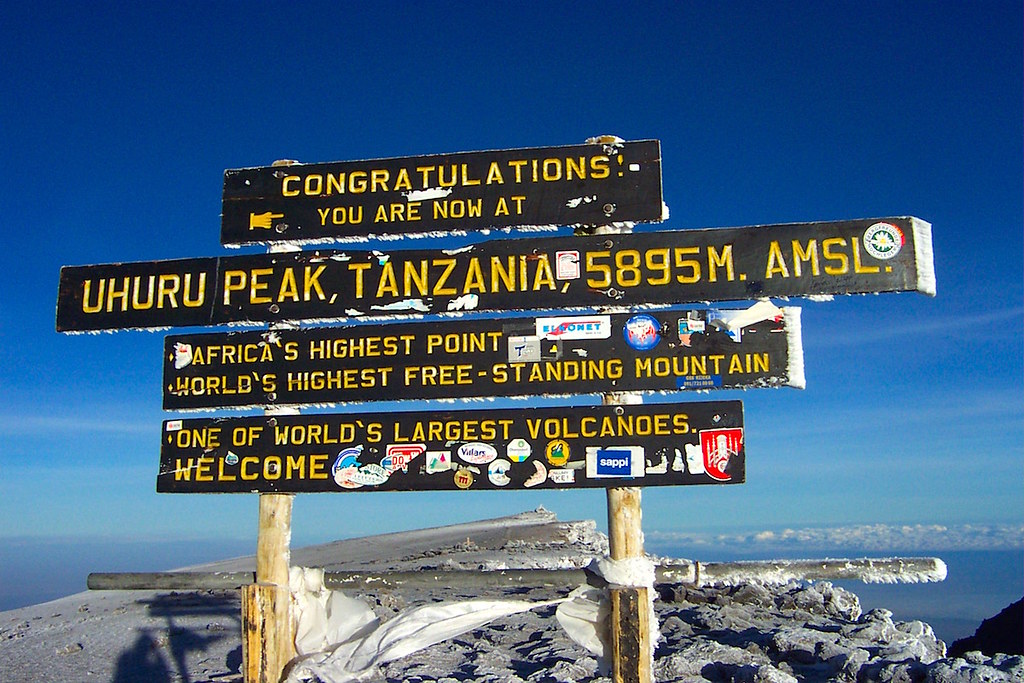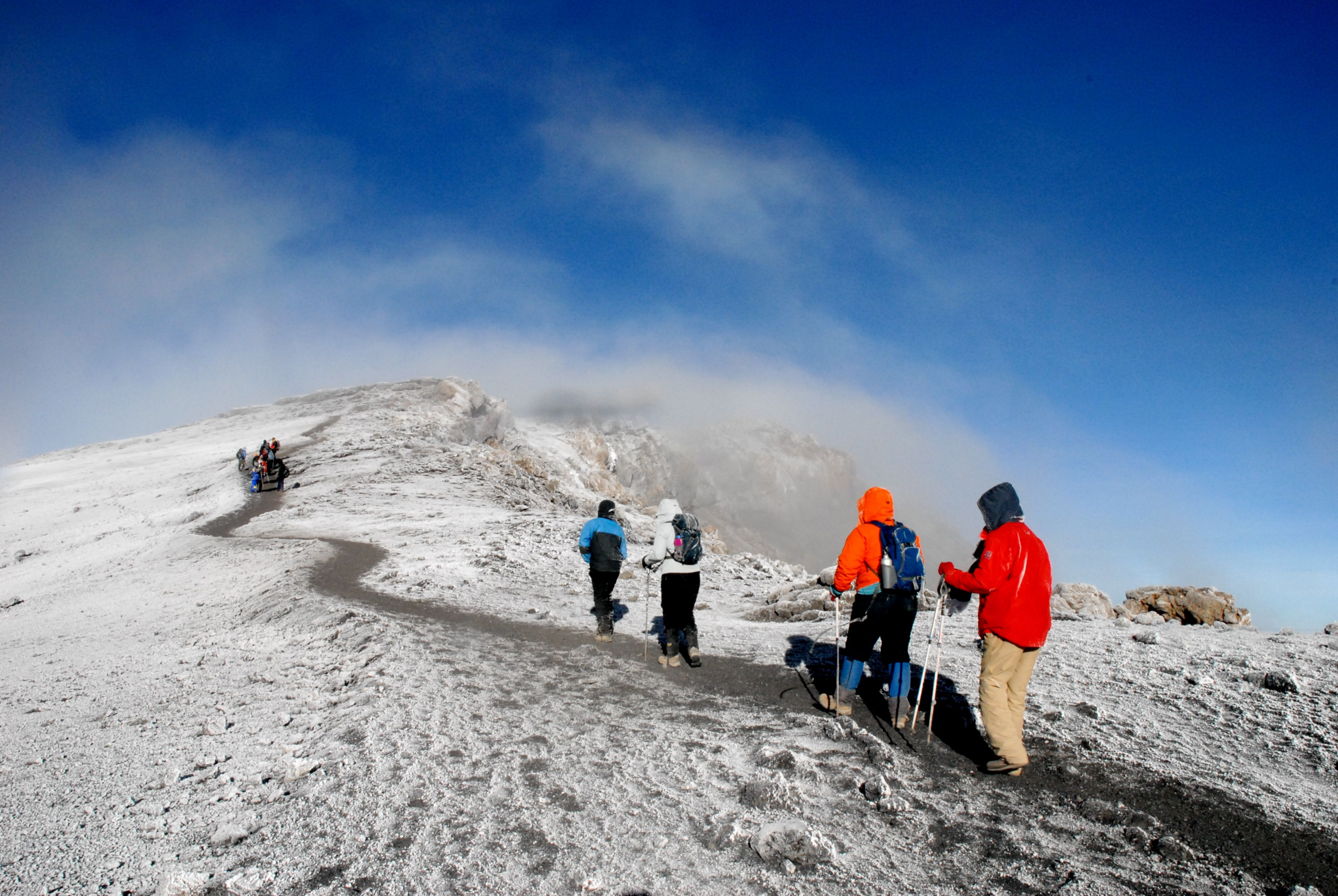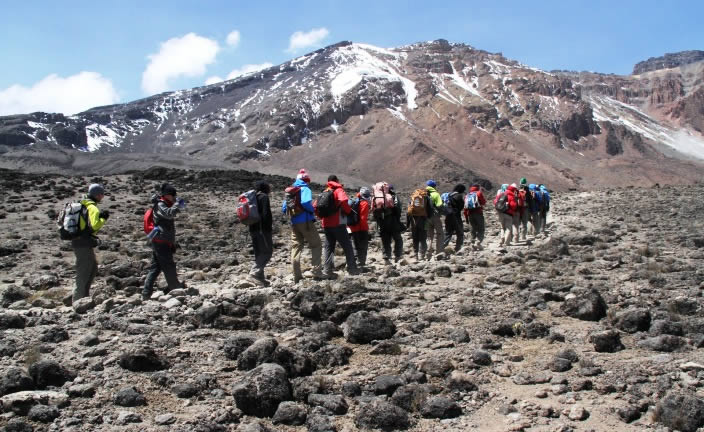Uhuru Peak is situated on Kibo, the highest of Mount Kilimanjaro’s three peaks, which include Mawenzi (5,149 meters) and Shira (3,962 meters). The name “Uhuru” means “freedom” in Swahili, and it was given to the place in 1961, when Tanganyika, which is now part of Tanzania, gained independence.

Mount Kilimanjaro, Africa’s highest peak and the world’s tallest free-standing mountain, is located in Tanzania. At 5,895 meters above sea level, the Uhuru Summit is Africa’s highest free-standing peak. Reaching Uhuru Peak, which is located on the volcanic cone Kibo and is part of Mt. Kilimanjaro, is the ultimate aim of 20,000–35,000 hikers each year. Uhuru is a spectacular walk with beautiful, picturesque views of Tanzania.
Mount Kilimanjaro, uhuru peak is accessible to hikers of all skill levels. Even a novice can reach Uhuru Peak and soak in the splendor of Africa’s highest point with the correct provisions and preparedness. An astonishing 40% of those who undertake the hike make it to the top (uhuru peak). Hikers are provided guided journeys up to the summit by five to eight distinct routes, each with varying levels of difficulty, with expert climbers on hand to assist guests.
UHURU PEAK/MOUNT KILIMANJARO CLIMATE.
The top of Uhuru Mount Kilimanjaro is also distinctive in terms of climate, as it goes through five separate ecosystems or climate zones from base to peak. Each zone is distinct from the others and has its own personality. The Cultivation Zone, Forest Zone, Heather-Moorland Zone, Alpine Desert Zone, and Arctic Summit climate zones are among them. On your journey to Africa’s tallest mountain, which generally takes five to eight days, you’ll cross through all of these zones.
The typical temperature at the base of Mt. Kilimanjaro is between 69- and 80-degrees Fahrenheit (21 and 27 degrees Celsius). On the other hand, the temperature can fluctuate between 32- and 22-degrees Fahrenheit (0 and -30 degrees Celsius), depending on the season and mountain zonation.

WHEN IS THE BEST TIME TO CLIMB TO UHURU PEAK? / CLIMB MOUNT KILIMANJARO
The months of January through early March, as well as June through October, are ideal for climbing Kilimanjaro Mountain. It’s the most comfortable hiking conditions because of the bright skies, amazing vistas, and sunshine. Regardless of the season, though, the weather has the potential to change abruptly. Kilimanjaro may be climbed at any time of year, but some months are better than others. We advocate climbing Mount Kilimanjaro during the driest months of the year. We stay away from April and November because these are the rainiest months of the year, making the trails more treacherous.
TOP 7 FUN FACTS ABOUT UHURU PEAK/ MOUNT KILIMANJARO
- While it is Africa’s highest peak, experienced athletes and climbers may reach Uhuru Peak in less than a day from the base of Kilimanjaro.
- Almost every climber who has reached the summit of Uhuru Peak, the highest peak on Kibo’s crater rim, has written down their thoughts in a book kept in a wooden box at the summit.
- The 87-year-old Frenchman, Valtee Daniel, was the oldest person to ever summit Mt. Kilimanjaro.
- Bruno Brunod of Italy completed the fastest verified ascent of Mt. Kilimanjaro in 2001, summiting Uhuru Peak in 5 hours, 38 minutes, 40 seconds. In 2004, local guide Simon Mtuy set a record for the fastest roundtrip, going up and down the peak in 8:27.
- The Marangu, Machame, and Umbwe routes all enter the peak from the south (Mweka is used only for descent). The Lemosho, Shira, and Northern Circuit routes all approach the summit from the west. From the north, the Rongai path approaches. The difficulty level varies depending on these routes, Some are simple enough for beginners, while others are so demanding that even experienced athletes struggle with the steep ascents and rapid altitude changes.

- Bernard Goosen, a South African, conquered Mt. Kilimanjaro twice in a wheelchair. His first summit took nine days in 2003; his second took only six days four years later. Goosen, who was born with cerebral palsy, climbed the mountain in an adapted wheelchair, primarily without help.
- Only around half of the climbers who attempt Mount Kilimanjaro succeed in reaching the summit. Altitude-related difficulties are the most common reason for climbers’ failing to reach the uhuru peak.
CONSIDERATIONS AND PREPARATION FOR THE HIKE TO UHURU PEAK
While climbing Kilimanjaro does not necessitate advanced climbing skills, there are a number of things visitors should consider and do in advance of their trip. It is critical to consider and prepare extensively for the trip in order to have the best chance of reaching the spectacular Uhuru Peak. Experts offer the following suggestions for consideration and preparation:
- Consider insurance and double-check that it will cover you. Most travel insurance policies limit the amount of hiking you can do. That means your policy will not cover you if you are wounded above a particular altitude.
- Prepare ahead of time. Every route on Kilimanjaro will have its own set of difficulties. You must ensure that you are physically healthy in order to meet and surpass those obstacles. While most days on the trail are quite straightforward, there are numerous elevations rises, and the final day might take up to 17 hours of hiking in a 24-hour period.
- Prepare yourself for a mental fight. Kilimanjaro is both a physical and a mental challenge. While the last day is physically demanding, it is also a mental challenge. Hiking for up to 17 hours in sub-zero temperatures in the dead of night, all while facing altitude and weather? Unless you can maintain your mental fortitude, that’s a prescription for disaster.
- Altitude medication should be brought with you. Everyone is affected by altitude in different ways. Because of that, some people who were less than an hour from the peak turned back. It is strongly advised that you bring and take altitude medication just in case it has any side effects, but it is necessary for the hike to Uhuru.
- Slow down—and then slow down some more. It is critical that you take it cautiously so that you can acclimate. This is something your mentors will be reminding you of all the time, so pay attention to them. The more slowly you move, the more likely you are to succeed.
- Bring some snacks with you. This is really crucial for your mental health. While the chefs on the mountain are amazing, we recommend bringing snacks so you have something to look forward to.
- It’s a good idea to have a water filter with you. During your hike, your porter team will make sure you have enough water. It’s gathered from various locations on the mountain, cooked, and served to you. The water is totally safe because it has been boiled.
ALTERNATIVE ROUTES/MAIN ROUTES FOR HIKING UHURU PEAK ON MOUNT KILIMANJARO
Marangu route: This is known as “the Coca-Cola route” since there are huts along the way where you may sleep and buy goods, such as a cold Coke. However, it has a low success rate since people misunderstand the difficulty and choose to rush to the top in five days rather than take more time to acclimate.
Machame route: This is the well-traveled path. It has a success record of over 60% when completed in seven days, which explains its appeal. It’s known as “the whiskey” path, implying that it’s a more difficult challenge than the Coca-Cola route.
Rongai route: This is the most straightforward approach to Uhuru Peak. It’s less scenic and takes longer, but it’s the only way to get there from the north. It’s also a lot less crowded.
Shira route: Before joining the Machame route, this route begins with several high-altitude increases. Because you start in the west before connecting with the main road, it’s more difficult and expensive.
Lemosho route: This is the most scenic path up the mountain, with plenty of variety and challenge. However, it is one of the more expensive options. This route is really intended for experienced climbers who are searching for a true test. In comparison to typical hiking, there is a lot of scrambling and climbing.


